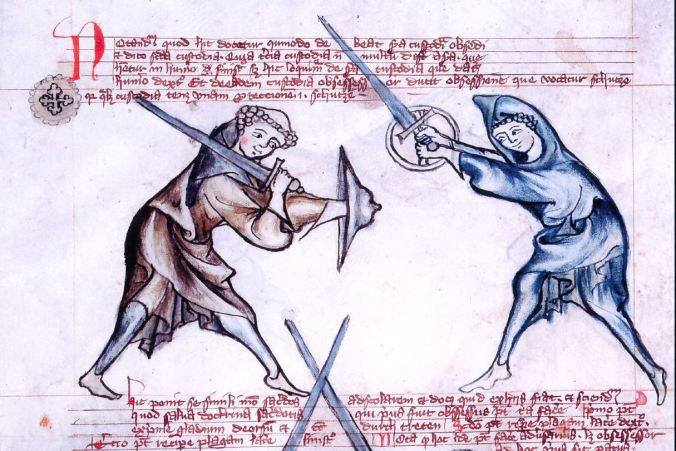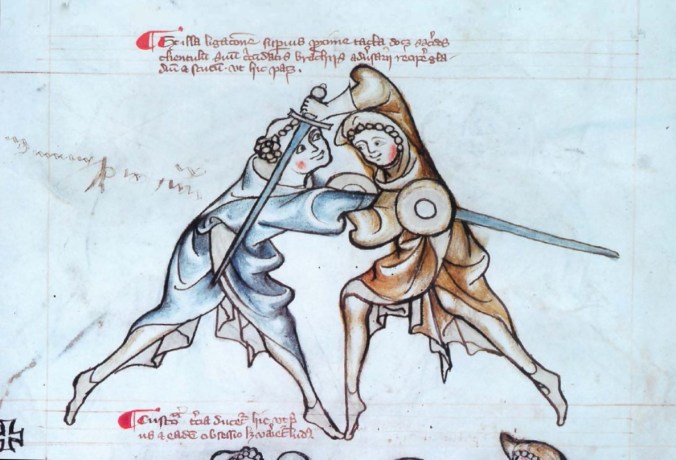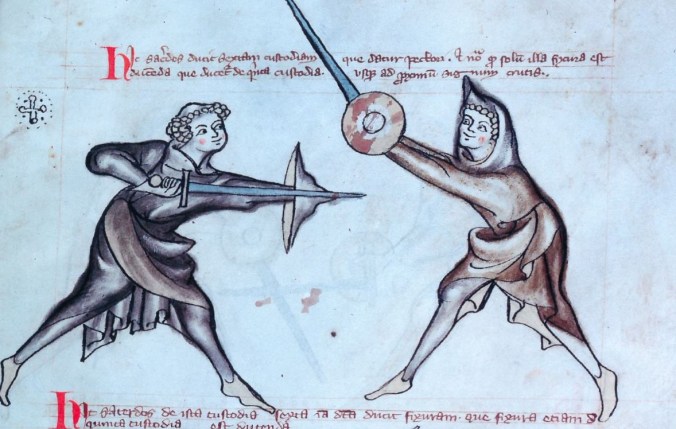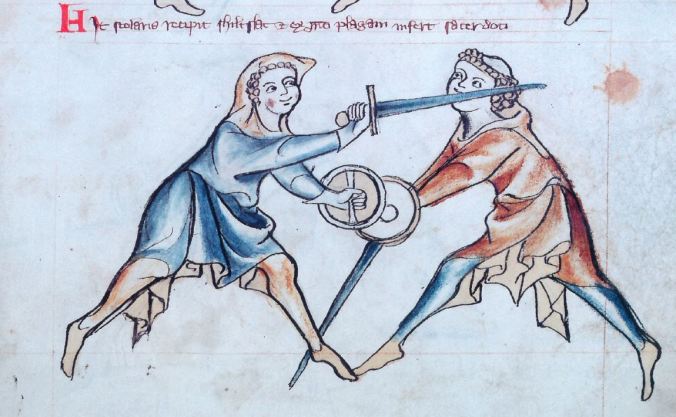One of my favorite games to play in museums is: “If I could steal one thing….” It goes without saying that my friends who actually work in museums do not approve of this game (although I do manage on occasion to cajole them into joining in). It goes further without saying that I have never and would never do such a thing. It’s a game for focusing the senses.
The blame for this morally dubious pastime rests at the base of the pedestal of a fascinating astrolabe in the one of the Vatican Museums. Mmm hmm. Yup. That’s where it all started: an old astrolabe. If you’re thinking that’s an odd choice to make out of the entirety of the Vatican Museum, then all I have to say is, your imagination is free to purloin whatsoever it chooses.
Back in 2011 when visiting the Musée de Cluny-Musée national du Moyen Âge, my “one thing” policy was seriously tested by their exhibition on the mythology and use of the sword. Finally, I narrowed it down to one manuscript illustrating combat techniques. Did I let myself get distracted by unique pommels? I did not. I’ll just take the manuscript, thank you. Did I fall for decorative incising down various handsome blades? Nope. Just the manuscript, please. In such cases, exhibition catalogues are generally how I reconcile myself to leaving things where they belong. So. the absolute non-existence of such a catalogue compounded my pain and agony a hundredfold. I had to make do with postcards and magnets of the manuscript. MAGNETS. There were not enough Sidecars in the whole of Paris to get me over that heartbreak.
Still nursing my disappointment (and perhaps a slight headache from those Sidecars), I made a pilgrimage to the Higgins Armory Museum in Worchester, MA upon my return, hoping to find solace in wandering the halls of armor, swords, pikestaffs, arquebuses, hauberks, and the like. While the displays included no manuscripts on sword fighting, in the gift shop I found The Medieval Art of Swordsmanship: a Facsimile and Translation of Europe’s Oldest Personal Combat Treatise, Royal Armouries MS.I.33. I suspect that my calloohs, callays, and chortles of joy were matched by those of the clerk in the gift shop who rang up my purchases that day. My many, many book purchases.
Within the pages of this particular gem are color facsimiles of a late 13th – early 14th-century manuscript on sword fighting wherein a priest in clerical robes (hood down) instructs a male student (hood up) and occasionally a woman, demonstrate a variety of offensive and defensive moves. While transcriber and translator Jeffrey Forgeng’s work is a serious work, worthy of the serious institution at which he and I did our doctorates (although at different times), I am entirely frivolous and will to leave it to readers to pick up the book (well worth it) and read the manuscript details (very interesting indeed) and textual details (cautionary).
Below I share only a few of my favorite “teaching moments”.

Readers, Meet your guide to sword fighting instructor (the priest at left) and his exemplary pupil (right). No matter what move they demonstrate, those happy smiles never waver. (Royal Armouries, MS I.33, p. 17)

This is the “Asphyxia” move where you get in close enough to discover if your opponent remembered his deodorant that morning. Since this is the Middle Ages, be warned: he didn’t. (Royal Armouries, MS I.33, p. 24)

If you look carefully, the student (right) is doing an alternative, less showy version of the “I am not left-handed!” move made famous by Wesley in the Princess Bride. No really. (Royal Armouries, MS I.33, p. 23)

Here, the master is demonstrating how to take advantage of distractions like low-flying planes and skewer your opponent while he’s yelling, “De plane! De plane!” (Royal Armouries, MS I.33, p. 33)

The deeply infantile “I’ve got your nose!” move that no one, NO ONE, finds amusing. (Royal Armouries, MS 1.33, p. 35)

The student is about to learn that Matrix moves do not work when dodging swords. Be warned. (Royal Armouries, I.33, p. 37)

My absolute favorite move, and one which will go over the heads of younger readers: “Wonder Twin powers, ACTIVATE!” (Royal Armouries, MS I.33, p. 57)
P.S. The Higgins Armory is no more, at least not as a private institution. The collection was acquired by the Worchester Museum where it is well worth visiting.
Works Cited: Jeffrey Forgeng, transcriber and translator, The Medieval Art of Swordsmanship: : a Facsimile and Translation of Europe’s Oldest Personal Combat Treatise, Royal Armouries MS.I.33. The Chivalry Bookshelf, CA, 2003.
Delightful. AHA! (And you thought I was left-handed…)
LikeLiked by 1 person
“Shape of a …. !!”
LikeLiked by 1 person
You may be the only person who gets that. Where the Wonder Twins purple or is my imagination totally warped ?
LikeLike
Great fun! I laughed out loud 🙂
LikeLiked by 1 person